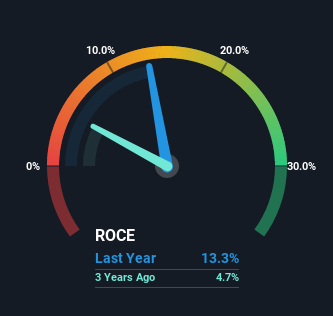- Israel
- /
- Construction
- /
- TASE:LUZN
Amos Luzon Development and Energy Group (TLV:LUZN) Is Looking To Continue Growing Its Returns On Capital
If we want to find a stock that could multiply over the long term, what are the underlying trends we should look for? Ideally, a business will show two trends; firstly a growing return on capital employed (ROCE) and secondly, an increasing amount of capital employed. If you see this, it typically means it's a company with a great business model and plenty of profitable reinvestment opportunities. So when we looked at Amos Luzon Development and Energy Group (TLV:LUZN) and its trend of ROCE, we really liked what we saw.
Return On Capital Employed (ROCE): What is it?
Just to clarify if you're unsure, ROCE is a metric for evaluating how much pre-tax income (in percentage terms) a company earns on the capital invested in its business. To calculate this metric for Amos Luzon Development and Energy Group, this is the formula:
Return on Capital Employed = Earnings Before Interest and Tax (EBIT) ÷ (Total Assets - Current Liabilities)
0.13 = ₪118m ÷ (₪1.5b - ₪648m) (Based on the trailing twelve months to December 2021).
So, Amos Luzon Development and Energy Group has an ROCE of 13%. In absolute terms, that's a satisfactory return, but compared to the Construction industry average of 7.4% it's much better.
See our latest analysis for Amos Luzon Development and Energy Group

While the past is not representative of the future, it can be helpful to know how a company has performed historically, which is why we have this chart above. If you want to delve into the historical earnings, revenue and cash flow of Amos Luzon Development and Energy Group, check out these free graphs here.
What Can We Tell From Amos Luzon Development and Energy Group's ROCE Trend?
Shareholders will be relieved that Amos Luzon Development and Energy Group has broken into profitability. While the business was unprofitable in the past, it's now turned things around and is earning 13% on its capital. Interestingly, the capital employed by the business has remained relatively flat, so these higher returns are either from prior investments paying off or increased efficiencies. So while we're happy that the business is more efficient, just keep in mind that could mean that going forward the business is lacking areas to invest internally for growth. Because in the end, a business can only get so efficient.
On a side note, Amos Luzon Development and Energy Group's current liabilities are still rather high at 42% of total assets. This can bring about some risks because the company is basically operating with a rather large reliance on its suppliers or other sorts of short-term creditors. While it's not necessarily a bad thing, it can be beneficial if this ratio is lower.
Our Take On Amos Luzon Development and Energy Group's ROCE
In summary, we're delighted to see that Amos Luzon Development and Energy Group has been able to increase efficiencies and earn higher rates of return on the same amount of capital. And a remarkable 197% total return over the last five years tells us that investors are expecting more good things to come in the future. So given the stock has proven it has promising trends, it's worth researching the company further to see if these trends are likely to persist.
Amos Luzon Development and Energy Group does have some risks, we noticed 3 warning signs (and 1 which doesn't sit too well with us) we think you should know about.
While Amos Luzon Development and Energy Group isn't earning the highest return, check out this free list of companies that are earning high returns on equity with solid balance sheets.
New: Manage All Your Stock Portfolios in One Place
We've created the ultimate portfolio companion for stock investors, and it's free.
• Connect an unlimited number of Portfolios and see your total in one currency
• Be alerted to new Warning Signs or Risks via email or mobile
• Track the Fair Value of your stocks
Have feedback on this article? Concerned about the content? Get in touch with us directly. Alternatively, email editorial-team (at) simplywallst.com.
This article by Simply Wall St is general in nature. We provide commentary based on historical data and analyst forecasts only using an unbiased methodology and our articles are not intended to be financial advice. It does not constitute a recommendation to buy or sell any stock, and does not take account of your objectives, or your financial situation. We aim to bring you long-term focused analysis driven by fundamental data. Note that our analysis may not factor in the latest price-sensitive company announcements or qualitative material. Simply Wall St has no position in any stocks mentioned.
About TASE:LUZN
Amos Luzon Development and Energy Group
Engages in the real estate development and construction business in Israel and internationally.
Solid track record with mediocre balance sheet.
Market Insights
Community Narratives



